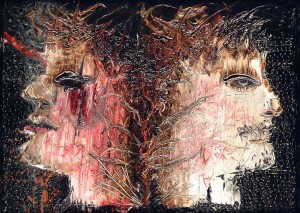Quick, which god is the month January named after? Each year, as we look back on the old year behind us and the new one ahead, we are in his realm. He is the lord of transition…and we don’t know who he is. On the whole, people don’t think of Jupiter when they think of a threshold. The role of “Guardian at the Gate” is usually given to Chiron, in his role as mediator between the inner planets and the outer, or Pluto, as the gatekeeper between the soul and the mundane world. Saturn doesn’t  count–Saturn is the end of the material world, and gatekeepers have to be able to straddle worlds, one foot in each domain. Jupiter, in his Sag guise as boundary breaker, is keen to gear up and pounce beyond the known, but solid Saturn always gets in his way. Jupiter always sees beyond Saturn, however, even if he can’t always get there, and in his role as co-ruler of Pisces, Jupiter has a definite role to play in creating the eternal circle, the ouroboros, and the transition between endings and beginnings.
count–Saturn is the end of the material world, and gatekeepers have to be able to straddle worlds, one foot in each domain. Jupiter, in his Sag guise as boundary breaker, is keen to gear up and pounce beyond the known, but solid Saturn always gets in his way. Jupiter always sees beyond Saturn, however, even if he can’t always get there, and in his role as co-ruler of Pisces, Jupiter has a definite role to play in creating the eternal circle, the ouroboros, and the transition between endings and beginnings.
When we are at Pisces, the end of the known, we are left trembling at the brink. Either we leap forward into the unknown, or we fall back into safety. This is the dilemma we also find at the Twelfth House–either we summon up our experience and our courage and take a leap of faith into the nothingness, trusting our own wisdom, or we deny ourselves the chance for rebirth. If we deny our spiritual rebirth, we tumble downwards into the bottom of the chart, into the I.C. and the Fourth House, which is the house of literal endings and beginnings, and literal death and birth.
The fish swim both ways with Pisces. At Pisces, there is always a turning point, a choice. We choose the darkness or we go into the light. Alas, with Pisces, sometimes the choice is to remain forever faltering in-between, living in a kind of permanent twilight. And that is when we have to pray to the Lost God.
The Romans worshiped him. He had a place of honour at all rituals, and was the reason Jupiter himself could cross the boundary between the world of the gods and the world of man. He stood at the gateway between heaven and earth, and was the one who had to be wooed for any safe crossings between. He was Janus, the god of transitions, and you could go nowhere without him. It has been suggested that he was the most important god in the Roman pantheon, and he was often invoked with Jupiter.
Those of you who are film fans know his face. Janus Films is a distribution company who have brought us the masterpieces of cinema since its origins in the 50’s–those of you who crave the films of Truffaut, Eisenstein, Antonioni, Fellini, Kirosawa, and many others are familiar with the god’s dual face as the company’s logo. But aside from this felicitous and apt connection (I like the thought of a distributor of foreign films likening themselves to the god of transitions) few of us know who Janus was.
Janus was, in fact, a buddy of both Jupiter and Saturn. He would have to be, wouldn’t he? With Saturn, he oversaw the practical transitions in life: doorways, bridges, archways. He embodied the transitional aspect of all things in the physical world. Janus’s associations with beginnings and movement have caused him to be associated with the passage of time, although time itself is Saturn’s domain. Time is ever in transition, we no sooner nail it than it is gone, and it seems to me that Janus is embedded within time in a much more direct way than Saturn. The dance of time and space creates matter, which is Saturn’s realm. I throw out the idea that Jupiter is associated with space itself. Janus seems to be a pivotal connecting point between the two, between infinity and the finite.
With Jupiter, Janus traversed the conceptual space between the mundane and the sacred. There were no sacrifices made without evoking his name. He is said to be partnered–or rather, bookended–with Vesta, who represented the opposite pole, the eternal flame within the limited life of man. Janus is the god of infinite possibility, because we are at the absolute beginning. In this way, he represents the true face of the more modern understanding of the workings of Jupiter. The freedom, and the sense of being unfettered, which is so familiar when Jupiter is around, stems from this unburdened opening towards experience. It is almost as if the inner planets represent faculties–or tools–we need on our journey: our creative life spark (the Sun), our instincts (the Moon), our intellect (Mercury), our ability to connect and draw in (Venus), our desire and urge to move forward (Mars). When we finally come to Jupiter, we are standing at the brink, at the beginning of the journey, the endless potential becoming concrete via time and experience (Saturn).
The urge to be great, to grow, to be larger than life, is Sag at heart, but also has to do with the limitlessness of Pisces. Jupiter is the desire to embody the All, something which is denied by the separative nature of material existence. (Those of us who have Jupiter prominent in our charts know this conflict intimately.) There is something about the Neptune rulership of Pisces that denies the basic human hungers. Neptune may represent a longing for the divine, but it doesn’t explain the compensatory behaviours that Jupiter’s rulership certainly does. Neptune wants to dissolve into the All, Jupiter wants to take it in and become the All. There’s a difference. Both are fighting the limits of material existence, but each has his own method, and which one will win out in your own chart has a lot to do with your Neptune and Jupiter placements.
Perhaps we should begin invoking the Lost God, Janus, to insure safe passage through all of our own transitions. There used to be a phrase, “Good beginnings make good endings,” which he would certainly have approved of. The British are fond of saying, “Start as you mean to go on.” (The ancient Brits, who were conquered by Romans obsessed with building roads, would certainly have encountered a Janus ceremony or two.) Janus looked over all first steps.
Our society seems to be plagued with the illness of worry. We spend hours, days, years fretting over what may never be. This is our reaction to the instability and volatility of our times. The Buddhists teach that worry is a mis-use of the imagination and of the vision-creating faculties in our minds. How much less anxious would we be if we felt there was a blessing available to invoke safe passage, a higher power looking over our shoulder during those precipitous and uncertain crossings. Perhaps the illusive, yes–dangerous– side of Jupiter as ruler of Pisces could be transformed, and we could be treated to a visionary peek at our own potential growth instead. We would trust that Jupiter predicates loss because he is creating space for that growth, and our eventual rebirth into something greater. Perhaps we need the Lost God of transitions now more than ever.
The above painting of Janus is by South African artist Christo Coetzee (1929-2001), oil on board. It can be found in the Sanlam Collection. Copyright c Christo Coetzee, all rights reserved.
Thank you to Rob Purday for finding the credits for us.

the painting is the work of South African artist Christo Coetzee 1929-2001 – the image is oil on board and is in the Sanlam Collection…..
Thank you, Rob. I’ll do my best to get permission.
the higher mind strongly under the influence of Jupiter and Sag seems to be truth avoidant when it comes to descending into difficult emotional work. there is something about Sag and Jupiter being sandwiched between Scorpio/Pluto and Capricorn/Saturn – that makes it almost instinctive for Jupiter to project and run from constraint and transformation. the right working of the mutable grand cross is linked up with the cardinal and fixed crosses.